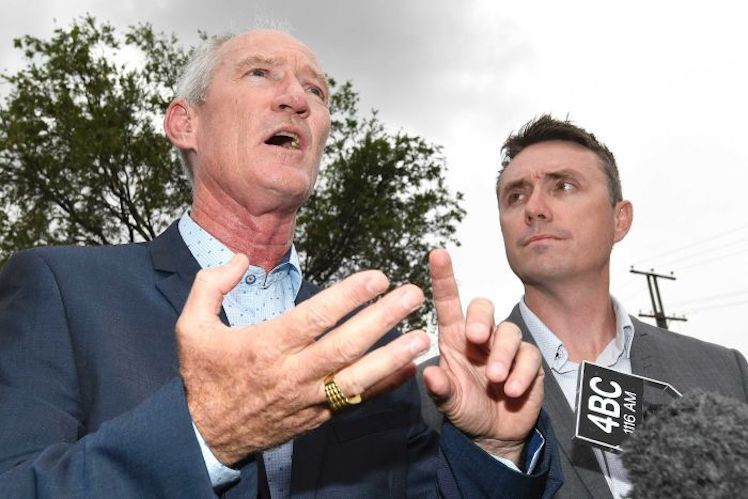Is this clickbait television? Does the headline allegation that One Nation went to the United States to lobby for a multi-million dollar donation from NRA in return for softening Australia’s gun laws stand up in the body of this story? Whilst not defending PHON, academic and journalist, Dr Martin Hirst, reminds those of us in the media that the use of entrapment remains a controversial subject.
LIKE MANY people, I was fascinated by Al Jazeera’s investigation, “How to sell a massacre“, into the relationship between Pauline Hanson’s One Nation and the American gun lobby group, the National Rifle Association.

The story broke in Australia with several teasers from the Al Jazeera program, which is screening in two parts. As I am writing this on Wednesday 27 March 2019, the second installment is not available in Australia via the Al Jazeera website, so my comments are qualified by the disclosure that I’ve only seen part 1.
Nevertheless, as one of the unwitting “stars” of the documentary, PHON fixer James Ashby claimed, a shit storm would erupt if news of his visit to Washington DC ever became public.
Indeed it has. PHON chief strategist and Hanson’s latest Svengali (or perhaps Rasputin), James Ashby, has been anxiously trying to play down the significance of the revelations in the Al Jazeera film.
It is important to nail down exactly what these revelations are, or could be, because the investigation has also raised a number of important questions and issues about journalism ethics.
Does “How to sell a massacre” pass the public interest test?
Public interest here is the key. We’re not just talking about the voyeur’s delight we might feel in watching two PHON honchos make total idiots of themselves. Sure, there is pleasure in that, but it is not a strong enough justification for the deception that was perpetrated in the name of pubic interest and disclosure.
In particular, when is an undercover sting operation, like the one at the centre of this story, justified by the public interest in getting “facts” out into the public domain.
My colleague, Andrew Dodd, has written a strong defence of the Al Jazeera sting for The Conversation. His defence hinges on a couple of points. The first is the motivation of the journalists making the story:
“Like many things, the answer might be dependent on the motivation. From where I stand, it looks like Al Jazeera’s motivation was to get to the heart of something fundamentally important that would otherwise remain opaque.”
Andrew Dodd, 26 March 2019
Andrew Dodd’s second point goes to a defence of what I call “dubious methods” in journalism. In our writing on journalism ethics over many years, my colleague Roger Patching and I have devoted thousands of words to a discussion of this issue.”Dubious methods” can only be justified with an overwhelming argument for public interest in the material uncovered by the use of subterfuge.
“Dubious methods” are exactly what we’re talking about in this case. The use of hidden cameras and the elaborate deception of Ashby and One Nation’s Queensland leader Steve Dickson by Rodger Muller. In his defence of Al Jazeera, Andrew Dodd focuses on the use of “hidden cameras”.
“It is highly likely the extent of One Nation’s behaviour could only be exposed through this sort of reportage. James Ashby is captured repeatedly reminding others they need to be secretive in their dealings with the NRA.
“The public has a clear right to know what One Nation is up to. This is especially the case when part of its mission is to learn new techniques to manipulate the public debate to pursue an agenda of overturning the ban on guns following the 1996 Port Arthur Massacre.” (Dodd)
This might be enough to justify the use of hidden cameras using a public interest defence; but what about the entrapment?
In my view, Andrew Dodd skates around this issue and suggests that the PHON operatives had an intent that pre-dates the introduction of the idea of visiting the NRA by Rodger Muller.
He also relies on Muller’s own account of this, which I think is partial and certainly biased towards a self-justifcation:

I’m not sure this is strong enough to convict Dickson and Ashby on the charge that they would have made the trip to the US and sought out the NRA without Muller’s intervention.
To assert a public interest defence for tricking PHON senate candidate Steve Dickson and party hack James Ashby over the period of several months, if not years, the “gotcha” moment has to be huge and it can’t just be an allegation made on the strength of implied comments and snippets of conversation between the marks and the shill.
The blockbusting allegation in the Al Jazeera documentary (at least in part 1) is that Dickson and Ashby went to the United States with the explicit aim of raising money — political donations — from the US gun lobby in order to fund the PHON 2019 election campaign.
Sure, there are hints that this is the case in the edited version of part 1 of “How to Sell a Massacre”, but I do not think I heard any really incriminating evidence that there was a serious “ask” involved.
Yes, I heard the grabs, but careful editing seems to have removed any hint of a prompt from Al Jazeera’s agent Rodger Muller. If you look closely at the restaurant scenes in which the money question is discussed. Dickson is looking directly at Muller in the external shots (How did they not realise they were being filmed at that point?), and I’m left with the impression that Muller could have been asking deliberately leading questions at that point which is a classic tool of entrapment.
In my view, there is enough damning footage and audio in the first part of the investigation to disqualify Dickson from being a candidate.
His casual racism is given full rein and his anti-Muslim, anti-Somali soundbites alone are disgusting.
I have no doubt that the PHON mission to the United States was to enlist some sort of support from the NRA and other pro-gun forces, but I am not convinced it was an out-and-out money grab.
And, let’s be completely frank about this, they were set up by Rodger Muller on behalf of Al Jazeera. The network went to great lengths to establish Muller’s cover story and embed him with the US gun nuts. This has to be looked at clearly as a case of media entrapment.
Muller instigated the idea of the trip and he offered to introduce the PHON characters to his contacts.
This is another indicator of a classic entrapment process that is common in law enforcement for both drug stings and counter-terrorism operations.
The basic operating procedure is to induce, cajole of threaten the mark into agreeing to do something illegal (buy or sell drugs/initiate a terrorist incident) and then arrest them in the process of enacting the transaction or preparing for the attack.

Many of these sting operations result in long jail terms, and even the death penalty, but they are convictions gained by unethical and perhaps even illegal means. It’s not OK when the cops do it, so why should it be OK in this context.
As many legal practitioners and scholars point out in relation to such controlled exposure operations, the mark/suspect is often convinced to do something that they would not ordinarily do, or that they actually wouldn’t do without the pressure being applied to them (flattery, promises or threats) by the law enforcement agents working undercover.
if we apply the same broad approach here, we have to admit there are questions about this practice.
We should also not forget the case of the Fake Sheikh.
British journalist Mazher Mahmood, aka the Fake Sheikh was (in)famous for carrying out journalistic sting operations over a long period of time for Murdoch’s now defunct News of the World. He also worked for The Sun and other Murdoch newspapers in the UK.

The Fake Sheikh was jailed in October 2016 for a sting he perpetrated on a young British pop star. He basically cajoled her into involvement in a drug purchase, set up and controlled by him. The carrot and stick approach was very clear in this case. The young woman was offered an opportunity to work with a record producer, but only if she scored the cocaine he wanted.
Pretty screwed, eh?
Well, how might you feel if the Al Jazeera trap was sprung against someone less deserving than PHON?
I want to make it clear, I am not defending PHON here, but I think we need to stop and reflect a moment or two on the journalistic methods used.
My short Twitter thread has attracted some interesting responses.
I've done a long thread to go with this https://t.co/3uYoP5rRF4
⚡️ “How to sell a documentary: Al Jazeera, PHON and media ethics.”https://t.co/m6kCyL5kQX
— Doc Martin (@ethicalmartini) March 27, 2019
Public support is vital so this website can continue to fund investigations and publish stories which speak truth to power. Please subscribe for the free newsletter, share stories on social media and, if you can afford it, tip in $5 a month.
Dr Martin Hirst is a veteran journalist, writer and independent scholar. In a career spanning 40 years in the media, Martin has written millions of words in news stories, magazine features, radio documentaries, academic articles, blogs and books. His most recent book, Navigating Social Journalism, was published by Routledge, New York, in October 2018.

 Dr Martin Hirst is a veteran journalist, writer and independent scholar. In a career spanning 40 years in the media, Martin has written millions of words in news stories, magazine features, radio documentaries, academic articles, blogs and books. His most recent book,
Dr Martin Hirst is a veteran journalist, writer and independent scholar. In a career spanning 40 years in the media, Martin has written millions of words in news stories, magazine features, radio documentaries, academic articles, blogs and books. His most recent book, 